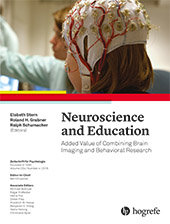Abstract
Abstract. Promised rewards are often used in education to stimulate learning behaviour. The present study tested whether a reward prospect affects semantic processing and recall of learned materials. Thirty-nine females participated in an electroencephalogram (EEG) task measuring semantic processing using the N400 effect. After that, they completed a cued recall test of the task materials. Before the EEG task, half of the participants (n = 20) were told that financial compensation would increase with each correct answer (reward prospect condition). The other half (n = 19) were told that financial compensation was fixed (control condition). Participants in the reward prospect condition showed an N400 effect that was more spread over the (left) frontal areas, and showed better recall than participants in the control condition. An achievement-related reward prospect alters semantic processing and improves retention of learned material. Whether improved retention benefits learning in longer term needs further study.
References
(2006). Reward-motivated learning: Mesolimbic activation precedes memory formation. Neuron, 50, 507–517. doi: 10.1016/j.neuron.2006.03.036
(2006). Executive function and the frontal lobes: A meta-analytic review. Neuropsychology Review, 16, 17–42. doi: 10.1007/s11065-006-9002-x
(2003). Working memory: Looking back and looking forward. Nature Reviews. Neuroscience, 4, 829–839. doi: 10.1038/nrn1201
(2001). Negative effects of reward on intrinsic motivation – A limited phenomenon: Comment on Deci, Koestner, and Ryan (2001). Review of Educational Research, 71, 29–42.
(2011). The relationship of language and emotion: N400 support for an embodied view of language comprehension. Journal of Cognitive Neuroscience, 23, 2400–2414. doi: 10.1162/jocn.2010.21578
(1994). Event-related potential components reflect phonological and semantic processing of the terminal word of spoken sentences. Journal of Cognitive Neuroscience, 6, 256–266.
(1999). A meta-analytic review of experiments examining the effects of extrinsic rewards on intrinsic motivation. Psychological Bulletin, 125, 627–668.
(2011). Role of test motivation in intelligence testing. Proceedings of the National Academy of Sciences, 108, 7716–7720. doi: 10.1073/pnas.1018601108
(2005). Both sides get the point: Hemispheric sensitivities to sentential constraint. Memory & Cognition, 33, 871–886. doi: 10.3758/bf03193082
(2003). Discrete coding of reward probability and uncertainty by dopamine neurons. Science, 299, 1898–1902. doi: 10.1126/science.1077349
(2001). Continuity of academic intrinsic motivation from childhood through late adolescence: A longitudinal study. Journal of Educational Psychology, 93, 3–13. doi: 10.1037/0022-0663.93.1.3
(1959). On methods in the analysis of profile data. Psychometrika, 24, 95–112. doi: 10.1007/bf02289823
(1994). Making the grade: What benefits students? Educational Leadership, 52, 14–20.
(2007). The power of feedback. Review of Educational Research, 77, 81–112. doi: 10.3102/003465430298487
(1995). D1/D5 receptor agonists induce a protein synthesis-dependent late potentiation in the CA1 region of the hippocampus. Proceedings of the National Academy of Sciences, 92, 2446–2450. doi: 10.1073/pnas.92.7.2446
(2017). The effect of anticipated achievement feedback on students’ semantic processing as indicated by the N400 cloze effect. Learning and Instruction, 47, 80–90. doi: 10.1016/j.learninstruc.2016.10.003
(2010). Prefrontal cortex mediation of cognitive enhancement in rewarding motivational contexts. Proceedings of the National Academy of Sciences, 107, 8871–8876. doi: 10.1073/pnas.1002007107
(2000). Removing electroencephalographic artifacts by blind source separation. Psychophysiology, 37, 163–178.
(1998). Expectation of reward modulates cognitive signals in the basal ganglia. Nature Neuroscience, 1, 411–416. doi: 10.1038/1625
(2013). Neuroscientific model of motivational process. Frontiers in Psychology, 4, 19–30. doi: 10.3389/fpsyg.2013.00098
(2003). Anticipation of reward in a nonaversive differential conditioning paradigm and the brain reward system: An event-related fMRI study. NeuroImage, 20, 1086–1095. doi: 10.1016/S1053-8119(03)00381-1
(2001). Anticipation of increasing monetary reward selectively recruits nucleus accumbens. The Journal of Neuroscience, 21, RC159
(2011). Thirty years and counting: Finding meaning in the N400 component of the event related brain potential (ERP). Annual Review of Psychology, 62, 621–647. doi: 10.1146/annurev.psych.093008.131123
(1980). Reading senseless sentences: Brain potentials reflect semantic incongruity. Science, 207, 203–205.
(2008). A cortical network for semantics: (De)constructing the N400. Nature Reviews. Neuroscience, 9, 920–933. doi: 10.1038/nrn2532
(2005). Intrinsic and extrinsic motivational orientations in the classroom: Age differences and academic correlates. Journal of Educational Psychology, 97, 184–196. doi: 10.1037/0022-0663.97.2.184
(2009). Choking on the money: Reward-based performance decrements are associated with midbrain activity. Psychological Science, 20, 955–962. doi: 10.1111/j.1467-9280.2009.02399.x
(2011). Money enhances memory consolidation – But only for boring material. Cognition, 119, 120–124. doi: 10.1016/j.cognition.2011.01.001
(2013). Predicting long-term growth in students’ mathematics achievement: The unique contributions of motivation and cognitive strategies. Child Development, 84, 1475–1490. doi: 10.1111/cdev.12036
(2006). Individual differences and contextual bias in pronoun resolution: Evidence from ERPs. Brain Research, 1118, 155–167. doi: 10.1016/j.brainres.2006.08.022
(2002). Meaningful learning: The essential factor for conceptual change in limited or inappropriate propositional hierarchies leading to empowerment of learners. Science Education, 86, 548–571. doi: 10.1002/sce.10032
(2010). FieldTrip: open source software for advanced analysis of MEG, EEG, and invasive electrophysiological data. Computational Intelligence and Neuroscience, 2011. doi: 10.1155/2011/156869
(2005). Latent motivational change in an academic setting: A 3-year longitudinal study. Journal of Educational Psychology, 97, 170–183. doi: 10.1037/0022-0663.97.2.170
(1996). D1/D5 dopamine receptor activation increases the magnitude of early long-term potentiation at CA1 hippocampal synapses. The Journal of Neuroscience, 16, 7478–7486.
(2011). Measuring emotions in students’ learning and performance: The Achievement Emotions Questionnaire (AEQ). Contemporary Educational Psychology, 36, 36–48. doi: 10.1016/j.cedpsych.2010.10.002
(2013). Interactions between mood and the structure of semantic memory: Event-related potentials evidence. Social Cognitive and Affective Neuroscience, 8, 579–594.
(2010). Effects of emotion and reward motivation on neural correlates of episodic memory encoding: A PET study. Neuroscience Research, 67, 72–79. doi: 10.1016/j.neures.2010.01.003
(2014). Remembering with gains and losses: Effects of monetary reward and punishment on successful encoding activation of source memories. Cerebral Cortex, 24, 1319–1331. doi: 10.1093/cercor/bhs415
(2009). The importance of motivation as a predictor of school achievement. Learning and Individual Differences, 19, 80–90. doi: 10.1016/j.lindif.2008.05.004
(2013). How robust is the language architecture? The case of mood. Frontiers in Psychology, 4. doi: 10.3389/fpsyg.2013.00505
(2006). Neural localization of semantic context effects in electromagnetic and hemodynamic studies. Brain and Language, 97, 279–293. doi: 10.1016/j.bandl.2005.11.003
(2005). Reward-related fMRI activation of dopaminergic midbrain is associated with enhanced hippocampus-dependent long-term memory formation. Neuron, 45, 459–467. doi: 10.1016/j.neuron.2005.01.010



